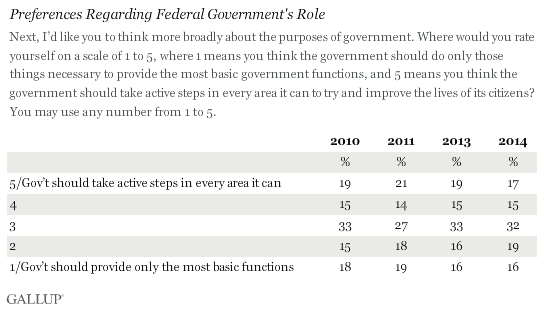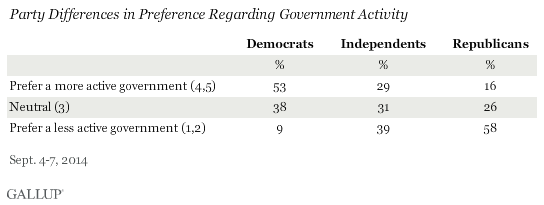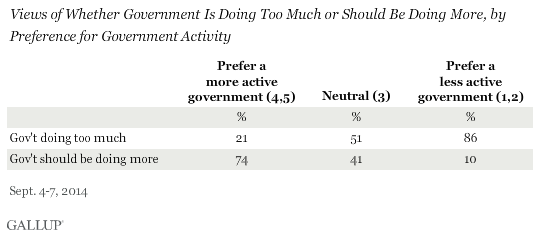PRINCETON, NJ -- Americans continue to divide almost evenly when asked to rate their preference for government activity on a 1-to-5 scale. Currently, 35% rate themselves a "1" or "2," indicating that they favor a limited government that "provides only the most basic government functions." Meanwhile, 32% rate themselves a "4" or "5," tending to prefer a government that "takes active steps in every area it can to try and improve the lives of its citizens." The remaining one-third of Americans fall in the middle.

Gallup has asked this question four times since 2010, and each time, Americans have divided themselves roughly into thirds favoring a more active government, a less active government, or something in between. This division is especially noteworthy because the government's role in solving the nation's problems has been arguably more salient in recent years during the housing crisis, financial crisis, economic recession, and passage of the Affordable Care Act.
Consistent with their respective parties' platforms, a majority of Democrats favor a more active government, while a majority of Republicans favor a more limited government. But party supporters are not entirely consistent with the approach to governing that the elected leaders from their party usually take. Substantial percentages of each party's supporters -- 38% of Democrats and 26% of Republicans -- place themselves in the middle on the 5-point scale. And one in six Republicans say they favor a more active government, while one in 10 Democrats favor a less active one.

Americans Say Government Doing Too Much Currently
When asked in a separate question about the government's current activity level, 54% of Americans say the government is "trying to do too many things that should be left to individuals and businesses." Meanwhile, 41% say the government should "do more to solve our country's problems."
Gallup has asked this question since 1992, including during four different presidential administrations -- two Republican and two Democratic. Americans' opinions appear to be influenced by which party is in the White House, and whether the president prefers a more active or a less active government. During the two Republican administrations, an average of 49% of Americans said the government was doing too much, compared with 55% during the two Democratic administrations.
Americans' preferences for government activity are highly related to their opinions of whether the government is currently doing too much. Those who prefer a limited government role on the 5-point scale overwhelmingly say the government is doing too much now (86%). At the same time, most of those who prefer an active government, 74%, say the government should be doing more right now. Those without a clear preference on this matter tilt in the direction of saying the government is currently doing too much.

Implications
Americans as a whole do not have a clear preference for whether the government should take an active role or a limited one. The public generally divides into equal thirds in favoring an active government, a limited government, or something in between. This division has been consistent during the five years Gallup has asked Americans to indicate their preferences.
The divided preferences on government activity do not give elected leaders clear direction in deciding whether to rely on government or nongovernment solutions to the nation's biggest problems. To some degree this may help explain why the president and Congress have had difficulty in addressing some of the major issues facing the country in recent years.
Survey Methods
Results for this Gallup poll are based on telephone interviews conducted Sept. 4-7, 2014, with a random sample of 1,017 adults, aged 18 and older, living in all 50 U.S. states and the District of Columbia.
For results based on the total sample of national adults, the margin of sampling error is ±4 percentage points at the 95% confidence level.
Interviews are conducted with respondents on landline telephones and cellular phones, with interviews conducted in Spanish for respondents who are primarily Spanish-speaking. Each sample of national adults includes a minimum quota of 50% cellphone respondents and 50% landline respondents, with additional minimum quotas by time zone within region. Landline and cellular telephone numbers are selected using random-digit-dial methods. Landline respondents are chosen at random within each household on the basis of which member had the most recent birthday.
Samples are weighted to correct for unequal selection probability, nonresponse, and double coverage of landline and cell users in the two sampling frames. They are also weighted to match the national demographics of gender, age, race, Hispanic ethnicity, education, region, population density, and phone status (cellphone only/landline only/both, and cellphone mostly). Demographic weighting targets are based on the most recent Current Population Survey figures for the aged 18 and older U.S. population. Phone status targets are based on the most recent National Health Interview Survey. Population density targets are based on the most recent U.S. census. All reported margins of sampling error include the computed design effects for weighting.
In addition to sampling error, question wording and practical difficulties in conducting surveys can introduce error or bias into the findings of public opinion polls.
View survey methodology, complete question responses, and trends.
For more details on Gallup's polling methodology, visit www.gallup.com.
